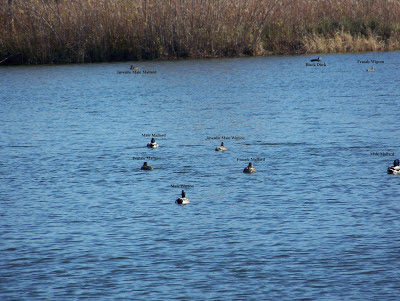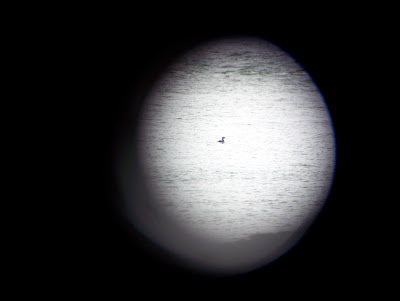(For those of you who are hypercompetitive, What Is It? (Round 6) is below this post)
The results of the poll that I had up on the side of the blog last month indicate that readers like owls. So I'll write a post about watching owls.
To tell the truth, your best chance of finding owls is to go to the Anita Purves Nature Center and go see the Eastern Screech Owls they have inside. As for wild owls, things are a bit trickier.
The main problem with watching owls, of course, is that they are primarily nocturnal. It's very unlikely that you'll be able to see them when they're most active (I've actually seen two owls in the middle of the night: one flew under a streetlight and the other I identified based on its reflection on a moonlit pond as it flew overhead).
Don't despair, though! It
is possible to see owls during the day.
But it's really hard.
HOW TO LOOK FOR OWLS:
One option is to try to find owls that are sleeping. Here are tricks for that:
1. Look in holes. Owls like to sleep in tree cavities or large birdhouses. Unfortunately, if the hole is big enough (like they prefer) they will not be visible from outside.
2. Check for "whitewash". Small owls often perch in the same tree many times. And while sitting there, they have to... well... do their business.
Time to learn about poop!
Unlike mammals, birds do not have separate liquid and solid waste. Instead, it all gets mixed up in the last stage of the bird's digestive tract. Solid waste is the little black or grey lumps. The white stuff that makes the wonderful little splats on the windshield of your car is the urine. Human urine packages the waste into the chemical urea, which is easy to synthesize but requires a lot of water to flush out of the excretory system. That's why human urine is clear. Birds, on the other hand, use the more complex chemical uric acid. Uric acid requires very little water to carry it out of the bird, so their urine is opaque and viscous.
Anyway, owls get rid of much of their solid waste by coughing up pellets--which means that only the white stuff comes out their rear end.
This brings us back to "whitewash", as we birders call it. You can check around the bottoms of small conifer trees for large deposits of deposits. If it's pure white or cream colored, check the area above you for owls. If there are dark bits, you may have found the favorite perch of some other bird of prey. If the poop is purple or red, that probably means that a flock of robins or waxwings was perched overhead at some time.
Whenever you're looking for owls, one piece of advice holds true:
FOLLOW THE CROWS.
Crows don't like owls. But they do like other crows. So when one of them finds an owl sitting in a tree, it'll start making lots of noise to get its friends to join in pestering the poor little owl. Eventually you end up with a flock of hundreds of crows circling one tree and constantly cawing. Whenever you see and hear this, go check out what they're so worked up over. It's not always an owl, but it will definitely be something big.
WHEN TO LOOK FOR OWLS:
The way to find owls activeduring the day is to go very early in
the morning or very late in the evening. Especially in winter. Owls are
forced to become crepuscular (active at dawn and dusk) or even diurnal
at that time of year because none of the yummy little rodents come out at night if it's freezing outside. For late evening owls, I suggest coming to the Woodcock Walk at Meadowbrook Park in
March--even though we're mostly looking for
Scolopax americana, we usually see an owl or two as well.
WHERE TO LOOK FOR OWLS:
In general, owls prefer dense forest. Especially with conifers. In winter, however, many of them move to open areas like frozen-over marshes. If you can find the two habitats combined (such as in Sax Zim Bog in Minnesota or Muscatatuck National Wildlife Refuge in Indiana) then you have a good shot at finding owls.
Here are some of the best spots around here for owls:
Busey Woods: There's usually at least one Barred Owl in here at some time of the year.
Northern Saw-Whet and Eastern Screech Owls are also possible.
Meadowbrook Park: Screech Owls and Great Horned Owls can be found on occasion. This is also the location of the Woodcock Walk in March.
Kickapoo State Park: The top location for Barred Owls in the area.
Clinton Lake: A good place to look for Northern Saw-Whet Owls, but you pretty much have to have an experienced birder with you who knows exactly where to look. Barred Owls are also found here.
If there's a really bad winter, Snowy Owls can be found in completely random places. If they're in the area, I'll let you know. But don't count on them showing up.
AND IF YOU CAN'T LOOK:
Owls are hard to see, but they aren't all that hard to hear. I've even heard a Barred Owl calling in my neighborhood. If you're going camping, wake up really early in the morning (4:00-5:00 or so) and listen for Barred Owls. They have a rather distinctive call.
To put in perspective how hard it is to find owls, here's my life total of owl sightings:
Barred Owl: 12+
Northern Saw-Whet Owl: 2
Eastern Screech Owl: 1
Unidentified: 2 (1 Great Horned or Long-Eared, 1 Barn or Short-Eared)
And here is my only photo of a wild owl:
 |
| Photo by the author |
This Barred Owl was at Muscatatuck National Wildlife Refuge in southern Indiana. I actually saw him several times, the first of which was using the FOLLOW THE CROWS method. The second time was pure luck, where he flew across the road as we were walking around looking for swans. The third time, when I got this picture, I was lucky to even notice him since he was just sitting there and not moving.
So chances of finding an owl by actively seeking them out are fairly low. They're more of something that shows up while you're looking for other birds. One of the other birders at the local Audubon Society says that for every 500 tree cavities he checks, only one has an owl in it.
Sorry if I just crushed anyone's dreams.
On the upside, there are plenty of other birds that you can see if you go birdwatching (hint, hint)















